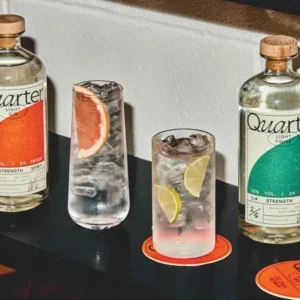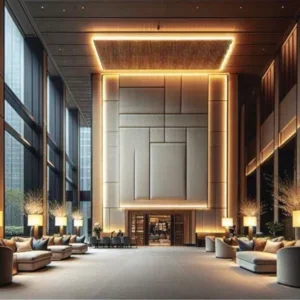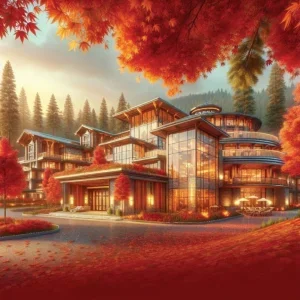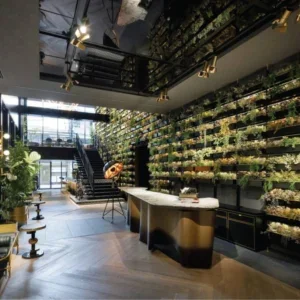It’s 10.30am at Galvin La Chapelle and 45 staff are about to take their lunch break.
Like most restaurants that open at noon, this establishment in London’s Spitalfields is a timezone unto itself. Here, days start early, finish late and are punctuated by improbably scheduled meals.
"It’s funny, as a chef you get used to having your lunch at ten in the morning," says Jeff Galvin, one of the brothers behind the Galvin brand. "Same with dinners at quarter-to-five."
Whatever the clock says, the chefs are owed a break; they’ve been beavering away since dawn. From the street outside, you can see glimmers of activity: delivery vehicles arriving, doors opening, a man scurrying down the kitchen steps carrying what appears to be a cabbage. Inside, the waiting staff are welcoming but brisk.
Jeff and Chris Galvin provide a zen-like counterpoint to the flurry. They are sitting side by side in the adjoining Café à Vin – Chris in a crisply pressed shirt, Jeff in his chef’s apron – and if you hadn’t known they were brothers, their speech patterns would eliminate any doubt. The conversation flows in that overlapping, easefully synced-up manner most commonly associated with married couples: sometimes they finish each other’s sentences, sometimes they answer on the other’s behalf. Right now, with a party from Finland due for lunch, they’ve decided to brush up on the langauge.
"How do I say hello, is it ‘kiitos’?" Chris asks one of the waitresses.
"No, kiitos is thank you," she corrects him. "Moi is hello."
"Moi?" says Chris, fumbling for the appropriate pronunciation. "Oh dear."
"Ah well, they all speak English," shrugs Jeff.
La Chapelle opened in 2009, the third restaurant to bear the Galvin name. The first was the Galvin Bistrot de Luxe in 2005, a classic French bistro in Baker Street that became an overnight sensation. At the time, there were no indications that this was the start of something major; it seemed more an incidental bridge between two similar but separate careers.
Chris, the older by 12 years, started out as a pot washer for Anthony Worrall-Thompson, before moving through the ranks at the Ritz and Lanesborough hotels, and the Ménage à Trois in New York. He joined Conran Restaurants in 1997, won his first Michelin star three years later, and opened the acclaimed Wolseley three years after that.
Jeff, meanwhile, emulated his brother in many ways, even down to scrubbing dishes in the same neighbourhood restaurant. After catering college, he worked at the Savoy Hotel, the Capital Hotel and Chez Nico, and was eventually appointed executive chef at Marco Pierre White’s L’Escargot. Much like Chris, he never strayed far from the sparkle of a Michelin star.
Curiously devoid of sibling rivalry, the Essex-born brothers had long dreamed of opening their own restaurant. In fact, they’d already worked together four times ("I’ve learned all Chris’s bad habits," admits Jeff) and knew the extent of their similarities and differences. Jeff is a chef and a chef above all else; Chris divides his time between the kitchen and the management side.
"You’ve got to be wise to survive in business," he points out. "I was always interested in the infrastructure of restaurants, so I guess it was a bit of a marriage coming together. All we ever wanted was the Bistrot, but the other bits that came along were the icing on the cake."
‘The other bits’ were six further restaurants. Galvin at Windows arrived a year later. With one of the best views in London, it is positioned on the 28th floor of the London Hilton on Park Lane. 2009 saw the opening of
La Chapelle and Café à Vin, and the Harrods-based Galvin Demoiselle followed in 2012. Later that year, they launched their first non-London restaurants, the Pompadour and the Brasserie de Luxe in Edinburgh’s Caledonian, a Waldorf Astoria Hotel.
These make for quite a portfolio, but Chris and Jeff are not concerned with empire building. They maintain that, while proud of what they’ve achieved, they’re even prouder of what they’ve turned down.
"What was important to us was being able to say no," says Chris. "When the Bistrot was successful, someone came along and said, ‘right, I’ve got 14 properties, let’s roll it out’. And we thought no, there’ll never be another Bistrot."
Each restaurant is unmistakably its own entity. Bistrot is rugged and rustic, Windows more refined. Harrods is a ‘petit Bistrot’ and the Scottish venture is based heavily on local produce. La Chapelle represents "fine dining with the edges knocked off". While all remain true to the fundamentals of French cuisine, this is a loosely grouped family as opposed to an army of clones.
A religious experience
The Galvins say they like trophy restaurants, and upon heading through into La Chapelle, it’s easy to see what they mean. A grade II listed Victorian building, formerly a girls’ school chapel, it was saved from destruction in the 1970s before lying dormant for 30 years. Only when converted into a restaurant did its potential become searingly clear.
It’s no longer a chapel, but the sense remains that we’re on hallowed ground: a 30m-high vaulted ceiling draws the eye heavenwards; halo-like lighting structures cast a glow over the calmly apportioned room. The schoolgirls of decades past would be proud. One such schoolgirl, now 104, is apparently a regular here.
Chris contends that, with the design bar set so high, it can be challenging to ensure everything else is on a par. "It’s a bit upsetting if people just come for the view, so it’s important you bring the level up – the food delivery has to match the surroundings," he says.
So far, there have been few complaints. Their culinary style is relatively pared down, giving centre stage to the quality of the produce: Anthony Worrall-Thompson has summed it up as ‘good honest food’. Meanwhile, their hospitality is industry-famous. Both brothers exhibit an almost prodigious lack of snootiness; a genuine, homespun warmth which finds a natural outlet in what they do.
Themselves part of a tight-knit clan, they don’t draw much of a distinction between restaurant and family life. Their middle brother, David, buys in their fruit and vegetables; Chris’s son cooks up a storm with Jeff, and his wife Sara is the patron of Galvin Demoiselle. Even their relationships with staff are deeply familial. Certain members of their brigade have been part of the fold for nearly 20 years.
This is an industry, after all, in which a great deal of trust is required. The Galvins say that they wouldn’t open another restaurant unless they had the right people; the success or failure of an enterprise lies squarely in their mentees’ hands. Their newest and northernmost venture, for instance, is overseen by Craig Sandle, a Michelin-starred Scottish chef who Chris dubs ‘McGalvin’.
"He’s like a fourth brother to us," he says. "He certainly has all the same characteristics as us: staff welfare is at the forefront; customer service and development of people."
With their background in hotels, alongside the Edinburgh restaurants and Galvin at Windows, how do they feel a hotel restaurant compares to its standalone equivalent?
"It’s worth remembering that in a restaurant, the curtain lifts twice a day, whereas in a hotel you’ve got to look after someone 24 hours," says Chris. "So it’s just making sure we avail ourselves to the customer’s needs. It could be that the guest has had a really tough journey, and then the first bit of their hotel experience is your restaurant. It’s important that we communicate with the hotel to find out."
Of course, many customers are not hotel guests at all; as so-called ‘name chefs’, the Galvin brothers drum up significant destination business. Especially in Scotland, the trend looks set to continue. With the Ryder Cup and Commonwealth Games happening nearby, 2014 bears the hallmarks of a promising year.
More broadly, it looks set to be a year of consolidation. In 2013, the brothers were offered around 20 different projects around the globe, but none stood out sufficiently to warrant a restaurant launch.
"You have to think carefully about why you’re doing it," says Chris. "It’s always exciting – you go and traipse round the building site, and say we could do this, do that. But then you have to say, should we? We’ve only got so much energy and so much time. You’ve got to be really honest and say, are all our restaurants as good as we want them to be, or can we work harder on things?"
For Chris and Jeff to work harder seems like a tall order: these are chefs who, despite their equanimity, describe their early years in the trade as ‘evil’. And while it has become easier over time to create some semblance of a work-life balance, their hours are still a long way from what an office worker would call cushty. Their energy, however, is infectious.
As Chris explains, "We’ve been up mountains, foraging; we’ve been on rare-breed farms; we’ve been out on boats, lobster pots, langoustine fishing and some of the greatest vineyards in the world, truffle hunting… It’s not a bad life really."
As opening time grows closer and the restaurant whirs into action, you’d be hard pushed to disagree.






